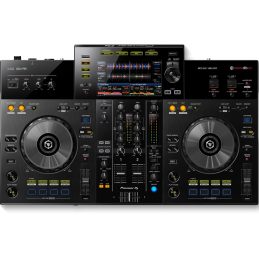
Dynamics, Condensers and Ribbons: How to Choose the Best Mic Type For You

An essential piece of equipment for the performing and aspiring DJ is the microphone. Like all DJ gear, there is a wide range of options on the market when it comes to mics: from features to sound quality, price and type, there’s plenty to consider.
While some musicians like to assume that the higher the price the better the microphone (and in some cases, when it comes to sound quality that’s true), it’s not always the case. In fact, by understanding the difference between dynamics, condensers, and ribbons you’ll be far more empowered to choose the best mic type for you and your needs.
In this article, we’ll run through the basics of each microphone type so that you can be as informed as possible when deciding and investing in your next piece of DJ equipment.
The 3 Main Types of Microphones
There are many different types of microphones, and they all bring different characteristics to the table. Some mics are designed to be more hardy and rugged, which makes them ideal for use on stage or during performances. Other microphones are far more fragile and delicate, but with that sensitivity comes greater subtlety in studio recordings.
There are, however, other practical differences between microphone types. Some mics can operate without a power source e.g., using a battery or some other external supply of power such as a preamp or mixing board.
To help you out, we’ll break down the three main types of microphones you should be considering.
Dynamic Microphones

Dynamic mics work by converting sound through electromagnetism into electrical signals. (Ribbon microphones are a subset of dynamic microphones, as are moving coil microphones.) Inside the mic is an inductive coil that is placed in a permanent magnetic field and connected to the ‘diaphragm’. When this diaphragm moves, the coil does too and then it produces the voltage and ultimately sound.
The key characteristic of dynamic mics is the fact that they can cope with high levels of sound pressure, which is why many DJs choose this type for use in live performances, on stage, or for recording in open/exposed environments.
Some dynamic microphones offer various other features, like shock mounting, which makes them particularly practical when being handled a lot or for use in high energy environments.
Dynamic mics are also known for their hardiness and durability even with frequent and prolonged use. Combine that with the fact that most mics are quite reasonably priced, and it offers very good investment value.
Condenser Microphones

Condenser microphones work a little differently from dynamic mics. Inside the condenser is a suspended lightweight diaphragm that is moved by the pressure of incoming sound waves. The capacitor, which is a metal backplate, is supplied with a low electronic charge that shifts the distance between the plate and the diaphragm to help vary the signal and output voltage. The diaphragm is significantly more sensitive than the one in a dynamic mic which is why condensers tend to pick up more subtle sounds.
It is important to note that condenser mics often do need a power source though some models come with internal batteries or can rely on the ‘phantom power’ that your mixer input supplies. Make sure to check your mixer to make sure it is compatible and offers phantom power as older models may not.
There are many subcategories of condenser mics that are niche for uses and applications, but in general, condensers are the preferred mic for use in studio recording settings. This is because delicate sounds and subtle frequencies are better picked up by a condenser, while the dynamic mic is ideal for louder, stronger, and bolder sounds.
Ribbon Microphones

Ribbon microphones sometimes referred to as ribbon velocity microphones feature a thin film of electrically conductive ribbon made from either aluminium, our aluminium or nanofilm. This ribbon uses electromagnetic induction to produce a voltage and is placed between the magnet poles in the microphone.
Similar to how a dynamic mic works, ribbon mics use the ribbon (as opposed to the diaphragm) to vary the voltage and sound output.
Ribbon mics are quite versatile in use and application but are often favoured for use in recording studios, especially when recording vocals since they tend to soften the sounds and make the recorded audio feel “warmer”.
How to Choose the Right Microphone
So how do you choose which microphone is right for you? Here are some handy considerations to consider and help direct your decision.
1. Use

Think about what you’re going to be using your microphone for. Are you recording in your home or a professional studio or do you need a simple plug-and-play, robust piece of equipment for mobile DJing and live performing?
2. Polar Pattern
The term polar pattern refers to the directional pattern type of a microphone. The more focused the polar pattern the better for use with vocals and narrow sound recordings. The wider the polar pattern the more environmental and ambient noise will be picked up.
3. Frequency Response

The microphone’s frequency response indicates what level of frequency it is designed to pick up. Lower frequencies think baritone voices and bass drums, may favour different types of microphones. The size of a diaphragm determines the frequency response. The smaller the diaphragm the higher the frequency response.
4. Your Voice

Always experiment and check any microphone you’re considering ensuring that it is suitable for your particular voice and needs. Sometimes it’s worth even renting a particular model you’re thinking of purchasing to try it out thoroughly before committing to buying it. Different voices and different DJs prefer different types of microphones. There’s simply no one-size-fits-all solution.
5. Cost
Price is always important especially if you’re just starting out and operating on a tight budget. Not all microphones with higher prices offer better quality. Sometimes the more affordable mics do the job best, while fancier ones simply bring unnecessary features to the table that you may not want or need.
6. Extra Accessories

Pop Filters
A pop filter is a screen placed between your mouth and the microphone and is used to reduce the air impact from your mouth that can translate through the microphone into noise. If you’re going to be talking or relying on vocals a lot, it’s worth considering choosing the right pop filter to go with your microphone.
-
 Free Shipping$129
Free Shipping$129sE Electronics Isolation Pack Shock Mount and Pop Filter
-
 Free Shipping$269
Free Shipping$269Aston Element Bundle Studio Microphone
-
 Free ShippingOriginal price was: $169.$160Current price is: $160.
Free ShippingOriginal price was: $169.$160Current price is: $160.Aston Swiftshield Shock Mount and Pop Filter Set
Shock Mounts
Shock mounts are used to hold the microphone in place and prevent vibrational sounds often caused by using stands. They are particularly good for stationary recording, though are not required or useful for every situation.
-
 Free ShippingOriginal price was: $108.$95Current price is: $95.
Free ShippingOriginal price was: $108.$95Current price is: $95.Rode SM6 Shock Mount with Detachable Pop Filter
-
 Free Shipping$319
Free Shipping$319Neumann EA4 Shock Mount for Condenser Microphones
-
 Free Shipping$1499
Free Shipping$1499Neumann TLM 102 Studio Set Condenser Microphone
Mic Drop by Choosing the Right Microphone
If you’re not sure how to choose the best mic type for you, make sure to reach out to the DJ City team. We’d be more than happy to discuss the pros and cons of dynamic, condenser and ribbon mics as well as talk through the particulars of your requirements and what you intend on using the mics for.
At the end of the day, specs and features vary from microphone to microphone and what’s right for you may not be right for someone else. Take your time to look at the different options and feel free to get in touch if you need.










